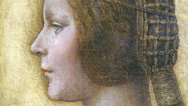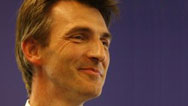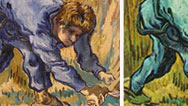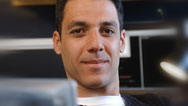Art Authentication
- Posted 07.02.08
- NOVA scienceNOW
(This video is no longer available for streaming.) Vincent van Gogh has inspired several talented artists to turn their hands to forgery. Can computers be used to identify which works are really his? To find out, NOVA scienceNOW, working in cooperation with the Van Gogh Museum in Amsterdam, commissioned an expert in art reconstruction to make a meticulous copy of a van Gogh painting. Then, we challenged three different computer teams—from Princeton, Penn State, and Maastricht universities—to see if they could spot the imitation in a group that included five genuine van Goghs.
Transcript
ART AUTHENTICATION
PBS Airdate: July 2, 2008
NEIL deGRASSE TYSON: How do you identify a true masterpiece? We don't usually think of a great painting as something that can be reduced to numbers.
Got a couple more threes right over here.
But a few scientists might disagree. They say that if you take away the color and break down a painting, brushstroke by brushstroke, you'll find a complex pattern of numbers, a pattern unique to every artist. And as correspondent Chad Cohen reports, it could provide a crucial clue if you're trying to tell the real thing from a clever forgery.
CHAD COHEN: Deep in the storage vault of the Van Gogh Museum, in Amsterdam, a precious canvas is being photographed. The Reaper, painted by Vincent van Gogh in 1889, has the thickly layered paint and bold curves the artist is so famous for. But are we looking at the real thing? Because there are two Reapers in this vault, one, as you might expect, worth millions; the other, a copy, worth no more than the oil and canvas it was painted with. Can you tell the difference? It's something hundreds of collectors ask the Van Gogh Museum to do every year, convinced they own a masterpiece by the great artist.
SJRAAR VAN HEUGTEN (Head of Collections, Van Gogh Museum): We get many questions for expertise here. Our opinion is asked all the time. And there are many fakes that have been around for decades.
CHAD COHEN: This is one of 30 fake van Gogh's created by a German art dealer named Otto Wacker, in the 1920s. He came up with the ingenious method of priming his canvases with white lead paint, to build up the thick layers van Gogh is famous for, then added bright colors on top. For a few years, the Wacker forgeries managed to fool the greatest van Gogh experts in the world.
SJRAAR VAN HEUGTEN: It is a problem. It is a problem for any renowned artist, because money, of course, is very tempting.
CHAD COHEN: This is serious money: 50, 70, 80 million dollars a piece for some of the best known paintings. Even the Van Gogh Museum was fooled into buying a fake back in the 1970s. It's a 19th Century painting called View of the Ij, Amsterdam's inner harbor. It wasn't originally intended as a fake, but years later someone forged van Gogh's signature onto the canvas. So how do you determine if a painting is the real thing? In May of 2007, the Van Gogh Museum explored one of the latest scientific methods of art analysis, by hosting the first international workshop on computer image processing.
ERIC POSTMA: These images are represented in terms of numbers.
CHAD COHEN: Eric Postma directed the technical presentation.
ERIC POSTMA: The purpose of the project was to look at these paintings and try to determine if we could distinguish between real and fake van Goghs.
CHAD COHEN: The computer scientists focused on one of the most revealing traits of van Gogh's work. As the museum's head conservator, Ella Hendriks showed us, it's the way he applied paint to his canvas.
ELLA HENDRIKS: I would tend to really want to get close and look at these, for example, these very nice white strokes, in the foreground, that were added at a late stage. If you look very close, you can see these, sort of, trailing drips of paints, as he literally scooped up the paint from the canvas, lifting his brush and then carrying the trail of paint.
CHAD COHEN: It turns out that van Gogh's brushstrokes are crucial markers, not only for critics and connoisseurs, but for computers as well.
ERIC POSTMA: The pattern of brushstrokes is very specific and very indicative of a painter. So the first selection that you make when you start to analyze these paintings digitally is to select the level of individual brushstrokes.
CHAD COHEN: The computer scientists create programs which examine a painting from different angles, to determine the direction of each brushstroke. Collecting the brushstroke patterns from more than 100 paintings establishes a baseline for van Gogh's style. But could the computer be fooled? Could an artist, specially trained to copy the old masters, duplicate van Gogh's style?
To find out, we commissioned Charlotte Caspers to carefully imitate every detail of van Gogh's brushstrokes. She's an expert in art reconstruction, using historical materials to copy famous paintings so museums can decide how to preserve the originals.
CHARLOTTE CASPERS (Artist and Conservator): The best would have been to sit next to the painting, but well, that was just not possible.
CHAD COHEN: The Van Gogh Museum doesn't allow artists to paint in front of the originals, so she made her own photos of The Reaper.
CHARLOTTE CASPERS: I couldn't bring the painting home, so I had to take a picture. And when it's a digital one, you can blow it up on your computer. So that is what I did.
CHAD COHEN: Knowing that the scientists would be focused on the pattern of van Gogh's brushstrokes, Charlotte's job was to perfectly match his technique.
CHARLOTTE CASPERS: I had a picture next to my canvas I was painting on. And I could blow that up so I could have a close look at the paint surface of the original painting from a picture.
CHAD COHEN: How do you think that trying to be him ultimately influenced the painting itself?
CHARLOTTE CASPERS: It's less spontaneous.
I was just switching all the time, my eyes, from my canvas to the picture and trying to do what he did. With charcoal, I did his outlines and near the folds and the indication of the face. And then I added yellows. And then, after that, I did something with dark lines. And then I added the highlights and the outlines. And I did the birds at the end. It was the last thing. It was fun to do.
CHAD COHEN: We had a young artist copy one of the master's paintings. Did you, did you get to see the copy?
ELLA HENDRIKS: I did get to see it, yeah.
CHAD COHEN: What'd you think?
ELLA HENDRIKS: I think she did a remarkable job because it's very...she's made a very accurate copy of the rhythm of the brushstrokes but managed to do it in a spontaneous way.
CHAD COHEN: So do you think she has a shot against the computers?
ELLA HENDRIKS: I think it will be a challenge, yeah.
CHAD COHEN: The challenge begins by turning Charlotte's copy of The Reaper into a color photograph, which is then turned into a high-resolution black and white scan.
Identified only by catalogue number, it takes its place beside five real van Gogh paintings, creating NOVA scienceNOW's test for three computer teams: Penn State University, Princeton University and Maastricht University. Eric Postma leads the Maastricht team.
So, here's a famous van Gogh.
ERIC POSTMA: Yeah.
CHAD COHEN: Van Gogh.
ERIC POSTMA: Van Gogh.
CHAD COHEN: Van Gogh.
ERIC POSTMA: Van Gogh.
CHAD COHEN: Van Gogh: The Sower.
ERIC POSTMA: The Zier.
CHAD COHEN: However you want to say it.
How do you begin? So you look at this, it's a beautiful painting. But you're going to strip it of its beauty, one layer of its beauty right now?
ERIC POSTMA: Yeah. In fact, what it'll be, because we translate the entire painting into numbers...
CHAD COHEN: Postma's software scans the whole painting, identifying areas of contrast. The more contrast, like the dark tree branch against the light sky, the larger the number assigned by the computer. If the contrast is less extreme, like the edge of the sun against the sky, the number is smaller. When all the contrast patterns are combined, a statistical portrait of van Gogh's style is created.
ERIC POSTMA: Well, these are genuine van Goghs. And this is a known fake, so-called "Wacker" fake. The faker tried too hard to mimic van Gogh.
CHAD COHEN: And by trying too hard, that means?
ERIC POSTMA: Too much.
CHAD COHEN: Painting too much?
ERIC POSTMA: Too much, exactly.
CHAD COHEN: Someone copying van Gogh paints too many brushstrokes to get it right, and the computer identifies them as areas of higher contrast. First the program analyzes the brushstrokes from six different angles then combines them to reveal areas where they overlap. More overlapping brushstrokes show up as brighter areas; fewer overlaps are dark.
Look at this famous painting van Gogh did of his bedroom. As the computer separates out each angle, it highlights the brushstrokes painted in that direction. Putting them all together reveals a brushstroke map of the painting. Now look at the Wacker forgery. The computer identifies more overlapping brushstrokes in every direction, 10 times as many as the van Gogh bedroom. The genuine van Gogh paintings display fewer brushstrokes than the forgery.
ERIC POSTMA: If you deliberately try to mimic van Gogh, then it's not natural anymore, and then you tend to overdo it. And this overdoing it results in high numbers. And that could be one way of detecting a fake.
INGRID DAUBECHIES (Princeton University): I'd like to see what zoom-in gives there.
CHAD COHEN: Ingrid Daubechies and the Princeton team have also been looking at the six paintings in our test, searching for the fake.
INGRID DAUBECHIES: If you try to make a copy, you would pay so much attention to what you're doing that you probably paint it more slowly and with more restrained hand than van Gogh himself would have painted, and we expect that to transfer, as well.
CHAD COHEN: For James Wang and Jia Li from Penn State University, Charlotte's copy seemed to blend in with the other five paintings.
JIA LI (Pennsylvania State University): Just by looking at the pictures, they all look very van Gogh, so that's why, later, we also tried a statistical modeling approach.
CHAD COHEN: All of the science teams had less than a week to distinguish the fake from the real van Goghs.
Would they pick The Sunflowers? The Sower? Any of the other three genuine van Gogh's? Or would any of their computer programs successfully choose Charlotte's version of The Reaper? The analysis is finished, and it's time to take her painting to the Van Gogh Museum, where the scientists are waiting.
Okay, the moment of truth. Do you all have an answer? We're ready to bring in the artist? Okay, Charlotte. This is Charlotte Caspers. She painted the painting that you guys tested.
INGRID DAUBECHIES: Very nice to meet you.
CHAD COHEN: Do want to come on over and reveal it? Well, bring it on over. Don't open it yet. Bring it. Bring it on over, Charlotte. All right, so what do you all got?
JAMES WANG (Pennsylvania State University): Six-eighty-seven.
CHAD COHEN: Six-eighty-seven.
INGRID DAUBECHIES: Six-eighty-seven, the one...
CHAD COHEN: You guys match. That's two for 687.
ERIC POSTMA: And that's three for 687.
CHAD COHEN: All right. That's your final answer? You're sticking with it?
INGRID DABUECHIES: Yes.
CHAD COHEN: All right. Charlotte, let's see.
INGRID DAUBECHIES: Yes, yes, yes. Yes. Yes!
CHAD COHEN: Six-eighty-seven, The Reaper.
SHANNON HUGHES: Oh, yes. Got it. Got it!
JAMES WANG: So how long did it take you to finish the painting?
CHARLOTTE CASPERS: I worked two days on this one.
ERIC POSTMA: How long did it take you to analyze the painting?
JAMES WANG: Oh, we took two days, too.
CHAD COHEN: In fact, van Gogh himself completed many of his most famous paintings in two days or less, and they've kept art collectors and experts busy for more than a century. They're not there yet, but computers will ultimately speed the process along.
ERIC POSTMA: The most valuable thing about these techniques is that it can help art experts. You just can scan over the entire painting. And they do it in a completely unbiased way, and that's the great advantage of computers.
Credits
Art Authentication
- Edited by
- Ben Ehrlich & David Chmura
- Produced and Directed by
- Dean Irwin
NOVA scienceNOW
- Executive Producer
- Samuel Fine
- Executive Editor
- Neil deGrasse Tyson
- Senior Series Producer
- Vincent Liota
- Supervising Producers
- Stephen Sweigart
- Joey David
- Editorial Producer
- Julia Cort
- Development Producer
- Vinita Mehta
- Senior Editor
- David Chmura
- Online Editor
- Laura Raimondo
- Series Production Assistant
- Fran Laks
- Assistant Editors
- Susan PerlaTung-Jen (Sunny) Chiang
- Compositors
- Brian EdgertonYunsik Noh
- Music
- Rob Morsberger
- NOVA scienceNOW Series Animation
- Edgeworx
- Associate Producers
- Heeth Grantham
- Anthony Manupelli
- Jeff Marion
- John Pavlus
- Camera
- Steve Baum
- Joe Brunette
- Brian Dowley
- Tom Fahey
- Marco Nauta
- Daryl Patterson-Pendana
- Jon Shenk
- Sound Recordists
- Clint Bramesco
- Michael Cottrell
- Doug Dunderdale
- Eric Leek
- Claudio Musajo
- Daryl Patterson-Pendana
- Assistant Camera
- Petr Stepanek
- Sound Mix
- David Chmura
- Animation
- Ben Fry
- Brian Edgerton
- Sputnik Animation
- James LaPlante
- Production Assistants
- Nadira Ilana
- Dan Sites
- Elizabeth Stachow
- Sylvia Vidurri
- For Lone Wolf Documentary Group
-
- Executive Producer
- Kirk Wolfinger
- Production Manager
- Donna Huttemann
- Archival Material
-
Corbis
National Human Genome Research Institute
Vulcan Productions - Special Thanks
-
Affymetrix
George Church
Ben Fry
Christopher Graves
Icelandic Tourist Board
Maryam M. Khani
Sam Krevor Petqua
Peter Renee Statoil
Hydro Thousand Days
Tucson 12
Jennifer Wade Hans Ziock - Neil deGrasse Tyson
- is director of the Hayden Planetarium in the Rose Center for Earth and Space at the American Museum of Natural History.
- NOVA scienceNOW Consortium Stations
- Nebraska Educational Telecommunications, NETPublic Broadcasting for Northern California, KQED Twin Cities Public Television, TPTWisconsin Public Television, WPT
- NOVA Series Graphics
- yU + co.
- NOVA Theme Music
- Walter Werzowa
John Luker
Musikvergnuegen, Inc. - Additional NOVA Theme Music
- Ray Loring
Rob Morsberger - Post Production Online Editor
- Spencer Gentry
- Closed Captioning
- The Caption Center
- Publicity
- Carole McFall
Eileen Campion
Lindsay de la Rigaudiere
Victoria Louie
Kate Becker - Senior Researcher
- Gaia Remerowski
- Production Coordinator
- Linda Callahan
- Paralegals
- Raphael Nemes
Sarah Erlandson - Talent Relations
-
Scott Kardel, Esq.
Janice Flood - Legal Counsel
- Susan Rosen
- Post Production Assistant
- Darcy Forlenza
- Associate Producer, Post Production
- Patrick Carey
- Post Production Supervisor
- Regina O'Toole
- Post Production Editors
- Rebecca Nieto
Alex Kreuter - Post Production Manager
- Nathan Gunner
- Compliance Manager
- Linzy Emery
- Business Manager
- Joseph P. Tracy
- Producers, Special Projects
- Lisa Mirowitz
David Condon - Coordinating Producer
- Laurie Cahalane
- Senior Science Editor
- Evan Hadingham
- Senior Series Producer
- Melanie Wallace
- Managing Director
- Alan Ritsko
- Senior Executive Producer
- Paula S. Apsell
This material is based upon work supported by the National Science Foundation under Grant No. 0638931. Any opinions, findings, and conclusions or recommendations expressed in this material are those of the author(s) and do not necessarily reflect the views of the National Science Foundation.
NOVA scienceNOW is a trademark of the WGBH Educational Foundation
NOVA scienceNOW is produced for WGBH/Boston by NOVA
© 2008 WGBH Educational Foundation
All rights reserved
- Image credit: (brush on canvas) © WGBH Educational Foundation
Participants
- Charlotte Caspers
- Artist and Conservator
- Chad Cohen
- Correspondent
- Ingrid Daubechies
- Princeton University www.pacm.princeton.edu/~ingrid/
- Neil deGrasse Tyson
- Astrophysicist, American Museum of Natural History www.haydenplanetarium.org/tyson/profile/bio
- Ella Hendriks
- Head of Conservation, Van Gogh Museum www3.vangoghmuseum.nl/vgm/index.jsp
- Jia Li
- Penn State University www.stat.psu.edu/~jiali/
- Eric Postma
- Maastricht University
- Sjraar Van Heugten
- Head of Collections, Van Gogh Museum www3.vangoghmuseum.nl/vgm/index.jsp
Related Links
-

Mystery of a Masterpiece
Art experts investigate whether a portrait sold for about $20,000 in 1998 is actually a lost Leonardo worth millions.
-

Art Authentication: Expert Q&A
Computer scientist Eric Postma of Maastricht University answers questions about the digital analysis of paintings.
-

Catching a Copy
See if you can tell a fake from a genuine van Gogh, and hear how one team of computer scientists did it.
-

Profile: Hany Farid
This self-proclaimed "accidental scientist" is a digital detective inventing new ways to tell if photos have been faked.



